Effects of Tank-Mix Adjuvants on Spray Performance Under Downwash Airflow Fields Using an Indoor Simulated UASS Spraying Platform
Abstract
1. Introduction
2. Materials and Methods
2.1. Spray Solution
2.2. Physiochemical Properties Characterization
2.3. Droplet Size Spectrum Measurement
2.3.1. Single-Rotor Downwash Airflow Field
2.3.2. Multi-Rotor Downwash Airflow Field
2.4. Spray Distribution Uniformity Measurement
2.5. Statistical Analyses
3. Results
3.1. Physicochemical Properties
3.2. Droplet Size Spectrum
3.2.1. Single-Rotor UASS Platform
3.2.2. Multi-Rotor UASS Platform
3.3. Spray Distribution Uniformity
3.3.1. Single-Rotor UASS Platform
3.3.2. Multi-Rotor UASS Platform
4. Discussion
5. Conclusions
Author Contributions
Funding
Data Availability Statement
Acknowledgments
Conflicts of Interest
Appendix A
| Treatment | D * (cm) | Droplet Size (µm) in Different Rotor Speeds | |||||||||||||||||||
|---|---|---|---|---|---|---|---|---|---|---|---|---|---|---|---|---|---|---|---|---|---|
| 0 rpm | 824 rpm | 962 rpm | 1072 rpm | ||||||||||||||||||
| DV10 | DV50 | DV90 | V100 | V200 | DV10 | DV50 | DV90 | V100 | V200 | DV10 | DV50 | DV90 | V100 | V200 | DV10 | DV50 | DV90 | V100 | V200 | ||
| Water | 0 | 84.17 | 126.06 | 192.42 | 27.47 | 67.37 | 82.40 | 124.27 | 201.99 | 30.02 | 66.09 | 78.88 | 113.60 | 175.48 | 35.32 | 78.47 | 80.11 | 112.04 | 179.69 | 36.39 | 77.85 |
| 30 | 84.27 | 154.04 | 216.07 | 22.84 | 47.76 | 84.87 | 125.22 | 193.20 | 28.14 | 67.39 | 84.43 | 121.34 | 180.92 | 28.79 | 73.47 | 82.91 | 124.53 | 191.08 | 27.68 | 70.17 | |
| 75 | 85.95 | 137.31 | 208.09 | 24.79 | 56.60 | 96.79 | 158.46 | 222.56 | 11.53 | 42.75 | 97.17 | 163.05 | 236.01 | 11.24 | 39.41 | 99.58 | 163.18 | 232.19 | 10.26 | 39.15 | |
| AGE852B | 0 | 87.68 | 166.83 | 228.07 | 19.70 | 38.24 | 87.09 | 153.30 | 219.94 | 21.19 | 48.17 | 97.44 | 164.46 | 228.03 | 11.18 | 37.45 | 86.77 | 154.09 | 228.90 | 20.36 | 47.35 |
| 30 | 88.98 | 163.24 | 220.41 | 17.68 | 39.09 | 85.58 | 126.27 | 194.29 | 26.11 | 68.06 | 83.43 | 151.99 | 227.01 | 21.89 | 48.65 | 82.22 | 141.24 | 267.48 | 22.60 | 55.24 | |
| 75 | 87.14 | 157.60 | 224.05 | 20.62 | 44.95 | 94.64 | 161.00 | 214.53 | 13.25 | 39.72 | 102.39 | 176.68 | 235.25 | 10.09 | 29.42 | 107.62 | 180.17 | 238.56 | 9.22 | 26.94 | |
| AGE825 | 0 | 86.28 | 129.83 | 192.11 | 24.61 | 65.70 | 83.95 | 116.96 | 185.55 | 32.27 | 70.67 | 88.94 | 136.78 | 192.08 | 20.34 | 59.82 | 86.02 | 137.18 | 209.35 | 20.40 | 60.71 |
| 30 | 87.27 | 149.52 | 200.46 | 20.23 | 50.45 | 85.87 | 125.06 | 226.99 | 24.12 | 70.38 | 91.70 | 149.68 | 310.49 | 15.73 | 50.54 | 85.30 | 146.97 | 304.38 | 20.50 | 51.58 | |
| 75 | 87.40 | 157.02 | 214.20 | 19.85 | 44.49 | 106.55 | 160.64 | 210.78 | 8.09 | 38.66 | 121.23 | 174.52 | 234.70 | 3.94 | 27.54 | 118.71 | 178.04 | 241.47 | 4.60 | 26.95 | |
| AGE809 | 0 | 88.18 | 170.71 | 230.15 | 19.54 | 44.98 | 92.84 | 176.78 | 279.32 | 13.61 | 36.35 | 88.07 | 162.42 | 260.96 | 16.95 | 42.84 | 91.80 | 194.48 | 323.27 | 14.75 | 34.76 |
| 30 | 89.85 | 171.72 | 233.08 | 11.91 | 28.94 | 92.30 | 176.67 | 241.27 | 14.24 | 33.26 | 92.15 | 162.38 | 224.52 | 14.53 | 40.36 | 89.11 | 158.86 | 228.60 | 17.55 | 44.09 | |
| 75 | 91.94 | 173.97 | 233.70 | 16.18 | 34.98 | 106.27 | 166.60 | 216.44 | 8.24 | 33.17 | 125.64 | 181.25 | 234.24 | 4.59 | 22.13 | 133.01 | 185.20 | 238.33 | 3.33 | 18.89 | |
| CCL846 | 0 | 89.69 | 168.65 | 230.46 | 16.96 | 38.54 | 96.28 | 192.61 | 514.33 | 11.53 | 29.21 | 90.24 | 170.33 | 237.47 | 15.91 | 37.52 | 89.92 | 170.44 | 259.94 | 15.91 | 38.41 |
| 30 | 123.81 | 198.39 | 268.62 | 5.13 | 18.96 | 106.64 | 184.53 | 241.44 | 9.03 | 24.09 | 94.04 | 176.40 | 233.20 | 13.05 | 30.43 | 91.72 | 179.53 | 239.14 | 14.45 | 30.03 | |
| 75 | 92.18 | 180.70 | 236.06 | 14.18 | 29.40 | 105.70 | 178.22 | 235.18 | 8.45 | 28.15 | 122.58 | 180.44 | 233.47 | 4.87 | 22.29 | 119.57 | 181.84 | 235.37 | 5.52 | 23.14 | |
| Treatment | D * (cm) | Droplet Size (µm) in Different Rotor Speeds | |||||||||||||||||||
|---|---|---|---|---|---|---|---|---|---|---|---|---|---|---|---|---|---|---|---|---|---|
| 0 rpm | 2200 rpm | 2400 rpm | 2600 rpm | ||||||||||||||||||
| DV10 | DV50 | DV90 | V100 | V200 | DV10 | DV50 | DV90 | V100 | V200 | DV10 | DV50 | DV90 | V100 | V200 | DV10 | DV50 | DV90 | V100 | V200 | ||
| Water | 0 | 84.72 | 165.33 | 271.27 | 5.69 | 12.18 | 81.20 | 173.14 | 286.77 | 5.09 | 11.65 | 91.25 | 182.40 | 297.07 | 3.78 | 12.04 | 74.84 | 160.37 | 271.67 | 5.47 | 11.31 |
| 15 | 84.11 | 170.49 | 283.62 | 4.97 | 11.66 | 73.15 | 141.72 | 252.21 | 8.55 | 9.59 | 75.95 | 147.88 | 257.18 | 6.84 | 10.43 | 79.76 | 154.38 | 258.33 | 6.60 | 11.19 | |
| 30 | 76.22 | 150.04 | 264.63 | 7.79 | 10.19 | 77.55 | 136.60 | 233.35 | 9.91 | 9.13 | 74.05 | 133.88 | 225.57 | 9.52 | 8.56 | 74.18 | 135.08 | 229.72 | 9.35 | 8.85 | |
| 45 | 80.99 | 140.70 | 243.59 | 10.09 | 9.63 | 80.99 | 140.70 | 243.59 | 10.09 | 9.63 | 81.36 | 148.63 | 242.53 | 7.58 | 11.14 | 80.78 | 146.57 | 241.07 | 8.84 | 10.76 | |
| 60 | 84.87 | 153.87 | 241.93 | 7.20 | 12.23 | 103.35 | 202.75 | 305.63 | 2.84 | 13.21 | 103.35 | 202.75 | 305.63 | 2.84 | 13.21 | 100.96 | 203.76 | 307.00 | 1.91 | 13.27 | |
| AGE852B | 0 | 83.14 | 168.02 | 281.64 | 5.60 | 11.54 | 92.69 | 184.13 | 299.53 | 3.77 | 12.18 | 91.25 | 182.40 | 297.07 | 3.78 | 12.04 | 93.32 | 187.42 | 296.48 | 3.62 | 12.21 |
| 15 | 85.63 | 157.09 | 249.06 | 6.61 | 12.49 | 89.45 | 163.88 | 272.23 | 4.99 | 12.28 | 88.12 | 160.06 | 265.26 | 5.08 | 12.06 | 86.85 | 164.65 | 285.39 | 4.59 | 11.73 | |
| 30 | 83.14 | 168.02 | 281.64 | 5.60 | 11.54 | 83.97 | 145.41 | 232.93 | 8.28 | 11.20 | 88.14 | 152.84 | 245.43 | 6.15 | 11.92 | 84.97 | 148.43 | 243.43 | 6.74 | 11.06 | |
| 45 | 89.63 | 149.64 | 247.00 | 10.17 | 10.44 | 88.31 | 149.42 | 232.20 | 7.17 | 11.93 | 89.11 | 151.84 | 237.06 | 6.32 | 12.25 | 90.26 | 155.14 | 243.01 | 5.97 | 12.59 | |
| 60 | 86.72 | 157.84 | 256.20 | 5.50 | 12.17 | 128.98 | 202.27 | 282.72 | 1.73 | 16.09 | 119.43 | 209.18 | 315.66 | 2.10 | 13.46 | 122.48 | 212.15 | 305.25 | 1.81 | 13.44 | |
| AGE825 | 0 | 107.72 | 172.10 | 241.24 | 4.35 | 16.79 | 116.86 | 186.98 | 260.44 | 2.88 | 17.66 | 116.52 | 187.10 | 265.07 | 2.87 | 17.00 | 119.22 | 188.77 | 267.47 | 2.47 | 17.17 |
| 15 | 98.22 | 163.88 | 247.35 | 7.12 | 13.61 | 100.89 | 162.56 | 237.88 | 6.18 | 15.05 | 100.91 | 170.92 | 251.72 | 5.94 | 15.15 | 99.90 | 170.04 | 251.85 | 6.26 | 15.08 | |
| 30 | 98.06 | 164.53 | 281.36 | 7.21 | 9.91 | 96.27 | 155.81 | 279.57 | 6.95 | 10.53 | 106.19 | 192.52 | 296.54 | 4.52 | 11.01 | 96.00 | 153.05 | 270.31 | 7.73 | 10.44 | |
| 45 | 95.96 | 162.37 | 271.47 | 7.32 | 11.89 | 98.30 | 161.46 | 265.04 | 6.35 | 12.50 | 97.42 | 157.23 | 261.90 | 6.73 | 12.33 | 100.05 | 164.15 | 265.72 | 6.02 | 12.80 | |
| 60 | 89.33 | 164.21 | 252.00 | 7.46 | 13.79 | 128.70 | 190.76 | 257.18 | 2.02 | 19.52 | 118.20 | 195.19 | 283.92 | 2.85 | 15.52 | 114.01 | 198.46 | 308.19 | 3.29 | 13.85 | |
| AGE809 | 0 | 100.67 | 200.62 | 339.90 | 3.20 | 11.11 | 108.10 | 204.24 | 310.75 | 2.66 | 12.47 | 104.03 | 197.76 | 310.64 | 3.06 | 12.24 | 101.17 | 197.69 | 307.54 | 3.10 | 12.09 |
| 15 | 105.40 | 207.98 | 320.94 | 3.06 | 11.24 | 95.34 | 186.75 | 307.33 | 3.49 | 11.81 | 93.68 | 182.65 | 302.19 | 3.48 | 11.79 | 98.15 | 187.56 | 301.30 | 3.47 | 12.04 | |
| 30 | 99.68 | 197.68 | 325.87 | 3.66 | 11.39 | 89.44 | 166.84 | 276.13 | 4.65 | 12.40 | 90.03 | 164.20 | 267.88 | 5.06 | 12.56 | 91.52 | 165.42 | 269.57 | 4.76 | 12.70 | |
| 45 | 92.40 | 190.66 | 311.04 | 4.37 | 10.91 | 95.87 | 171.62 | 272.49 | 4.47 | 13.00 | 93.77 | 168.45 | 262.99 | 5.01 | 13.44 | 96.33 | 170.06 | 275.59 | 4.41 | 12.95 | |
| 60 | 97.00 | 184.02 | 301.01 | 3.96 | 12.05 | 128.98 | 202.27 | 282.72 | 1.73 | 16.09 | 133.66 | 206.78 | 290.75 | 1.31 | 15.75 | 137.75 | 214.13 | 306.10 | 1.15 | 14.67 | |
| CCL846 | 0 | 114.33 | 198.55 | 276.92 | 3.26 | 14.79 | 123.39 | 206.26 | 279.49 | 1.93 | 15.35 | 128.81 | 211.42 | 303.46 | 1.65 | 14.37 | 128.33 | 208.42 | 286.01 | 1.51 | 15.36 |
| 15 | 113.36 | 208.23 | 305.47 | 3.49 | 11.00 | 113.90 | 200.58 | 292.30 | 3.50 | 13.59 | 119.45 | 207.74 | 296.61 | 2.87 | 13.64 | 121.64 | 211.55 | 305.09 | 2.58 | 13.02 | |
| 30 | 108.95 | 217.95 | 312.25 | 4.17 | 8.79 | 104.18 | 189.60 | 297.25 | 5.03 | 10.64 | 107.34 | 183.18 | 276.16 | 4.46 | 13.90 | 107.14 | 185.74 | 274.74 | 3.96 | 13.44 | |
| 45 | 104.60 | 202.95 | 310.93 | 5.14 | 9.10 | 105.42 | 188.35 | 288.40 | 4.48 | 12.25 | 106.29 | 185.63 | 282.68 | 4.39 | 12.83 | 106.65 | 186.39 | 281.68 | 4.26 | 12.81 | |
| 60 | 89.55 | 167.18 | 254.39 | 7.62 | 14.17 | 131.44 | 206.53 | 286.04 | 1.74 | 15.49 | 123.32 | 205.21 | 292.77 | 2.52 | 14.56 | 124.10 | 212.03 | 308.76 | 2.47 | 13.40 | |
References
- He, X.; Bonds, J.; Herbst, A.; Langenakens, J. Recent Development of Unmanned Aerial Vehicle for Plant Protection in East Asia. Int. J. Agric. Biol. Eng. 2017, 10, 18–30. [Google Scholar]
- Faiçal, B.S.; Freitas, H.; Gomes, P.H.; Mano, L.Y.; Pessin, G.; de Carvalho, A.C.P.L.F.; Krishnamachari, B.; Ueyama, J. An Adaptive Approach for UAV-Based Pesticide Spraying in Dynamic Environments. Comput. Electron. Agric. 2017, 138, 210–223. [Google Scholar] [CrossRef]
- Wang, G.; Li, X.; Andaloro, J.; Chen, P.; Song, C.; Shan, C.; Chen, S.; Lan, Y. Deposition and Biological Efficacy of UAV-Based Low-Volume Application in Rice Fields. Int. J. Precis. Agric. Aviat. 2018, 1, 65–72. [Google Scholar] [CrossRef]
- Hu, P.; Zhang, R.; Yang, J.; Chen, L. Development Status and Key Technologies of Plant Protection UAVs in China: A Review. Drones 2022, 6, 354. [Google Scholar] [CrossRef]
- Giles, D.K.; Billing, R.C. Deployment and Performance of a UAV for Crop Spraying. Chem. Eng. Trans. 2015, 44, 307–312. [Google Scholar] [CrossRef]
- Sánchez-Fernández, L.; Barrera, M.; Martínez-Guanter, J.; Pérez-Ruiz, M. Drift Reduction in Orchards through the Use of an Autonomous UAV System. Comput. Electron. Agric. 2023, 211, 107981. [Google Scholar] [CrossRef]
- Wang, C.; He, X.; Wang, X.; Wang, Z.; Wang, S.; Li, L.; Bonds, J.; Herbst, A.; Wang, Z. Testing Method and Distribution Characteristics of Spatial Pesticide Spraying Deposition Quality Balance for Unmanned Aerial Vehicle. Int. J. Agric. Biol. Eng. 2018, 11, 18–26. [Google Scholar] [CrossRef]
- Wang, S.; Song, J.; He, X.; Song, L.; Wang, X.; Wang, C.; Wang, Z.; Ling, Y. Performances Evaluation of Four Typical Unmanned Aerial Vehicles Used for Pesticide Application in China. Int. J. Agric. Biol. Eng. 2017, 10, 22–31. [Google Scholar] [CrossRef]
- Chen, P.; Lan, Y.; Huang, X.; Qi, H.; Wang, G.; Wang, J.; Wang, L.; Xiao, H. Droplet Deposition and Control of Planthoppers of Different Nozzles in Two-Stage Rice with a Quadrotor Unmanned Aerial Vehicle. Agronomy 2020, 10, 303. [Google Scholar] [CrossRef]
- Wang, L.; Xia, S.; Zhang, H.; Li, Y.; Huang, Z.; Qiao, B.; Zhong, L.; Cao, M.; He, X.; Wang, C.; et al. Tank-Mix Adjuvants Improved Spray Performance and Biological Efficacy in Rice Insecticide Application with Unmanned Aerial Vehicle Sprayer. Pest Manag. Sci. 2024, 80, 4371–4385. [Google Scholar] [CrossRef]
- Herbst, A.; Bonds, J.; Wang, Z.; Zeng, A.; He, X.; Goff, P. The Influence of Unmanned Agricultural Aircraft System Design on Spray Drift. J. Für Kult. 2020, 72, 1–11. [Google Scholar]
- Zheng, L.; Cao, C.; Chen, Z.; Cao, L.; Huang, Q.; Song, B. Efficient Pesticide Formulation and Regulation Mechanism for Improving the Deposition of Droplets on the Leaves of Rice (Oryza sativa L.). Pest Manag. Sci. 2021, 77, 3198–3207. [Google Scholar] [CrossRef] [PubMed]
- Shan, C.; Wu, J.; Song, C.; Chen, S.; Wang, J.; Wang, H.; Wang, G.; Lan, Y. Control Efficacy and Deposition Characteristics of an Unmanned Aerial Spray System Low-Volume Application on Corn Fall Armyworm Spodoptera frugiperda. Front. Plant Sci. 2022, 13, 900939. [Google Scholar] [CrossRef] [PubMed]
- Huang, Z.; Wang, C.; Wongsuk, S.; Qi, P.; Liu, L.; Qiao, B.; Zhong, L.; He, X. Field Evaluation of a Six-Rotor Unmanned Agricultural Aerial Sprayer: Effects of Application Parameters on Spray Deposition and Control Efficacy against Rice Planthopper. Pest Manag. Sci. 2023, 79, 4664–4678. [Google Scholar] [CrossRef]
- Zhang, P.; Deng, L.; Lyu, Q.; He, S.L.; Yi, S.L.; De Liu, Y.; Yu, Y.X.; Pan, H.Y. Effects of Citrus Tree-Shape and Spraying Height of Small Unmanned Aerial Vehicle on Droplet Distribution. Int. J. Agric. Biol. Eng. 2016, 9, 45–52. [Google Scholar] [CrossRef]
- Yan, X.; Wang, M.; Zhu, Y.; Shi, X.; Liu, X.; Chen, Y.; Xu, J.; Yang, D.; Yuan, H. Effect of Aviation Spray Adjuvant on Improving Control of Fusarium Head Blight and Reducing Mycotoxin Contamination in Wheat. Agriculture 2021, 11, 1284. [Google Scholar] [CrossRef]
- Wang, C.; Liu, Y.; Zhang, Z.; Han, L.; Li, Y.; Zhang, H.; Wongsuk, S.; Li, Y.; Wu, X.; He, X. Spray Performance Evaluation of a Six-Rotor Unmanned Aerial Vehicle Sprayer for Pesticide Application Using an Orchard Operation Mode in Apple Orchards. Pest Manag. Sci. 2022, 78, 2449–2466. [Google Scholar] [CrossRef]
- Liu, Y.; Xiao, Q.; Han, X.; Zeeshan, M.; Fang, Z.; Dou, Z. Effect of Aerial Application of Adjuvants on Pepper Defoliant Droplet Deposition and Efficacy of Defoliation Sprayed by Unmanned Aerial Vehicles. Front. Plant Sci. 2022, 13, 917462. [Google Scholar] [CrossRef]
- Zhao, R.; Sun, Z.; Bird, N.; Gu, Y.; Xu, Y.; Zhang, Z.; Wu, X. Effects of Tank-Mix Adjuvants on Physicochemical Properties and Dosage Delivery at Low Dilution Ratios for Unmanned Aerial Vehicle Application in Paddy Fields. Pest Manag. Sci. 2022, 78, 1582–1593. [Google Scholar] [CrossRef]
- Zhao, R.; Yu, M.; Sun, Z.; Li, L.; Shang, H.; Xi, W. Using Tank-Mix Adjuvant Improves the Physicochemical Properties and Dosage Delivery to Reduce the Use of Pesticides in Unmanned Aerial Vehicles for Plant Protection in Wheat. Pest Manag. Sci. 2022, 78, 2512–2522. [Google Scholar] [CrossRef]
- Guo, S.; Li, J.; Yao, W.; Hu, X.; Wei, X.; Long, B. Optimization of the Factors Affecting Droplet Deposition in Rice Fields by Rotary Unmanned Aerial Vehicles (UAVs). Precis. Agric. 2021, 22, 1918–1935. [Google Scholar] [CrossRef]
- Cavalaris, C.; Tagarakis, A.C.; Kateris, D.; Bochtis, D. Cost Analysis of Using UAV Sprayers for Olive Fruit Fly Control. AgriEngineering 2023, 5, 1925–1942. [Google Scholar] [CrossRef]
- Li, Y.; Han, L.; Liu, L.; Huang, Z.; Wang, C.; He, X. Design and Spray Performance Evaluation of an Air–Ground Cooperation Stereoscopic Plant Protection System for Mango Orchards. Agronomy 2023, 13, 2007. [Google Scholar] [CrossRef]
- Zhong, Y.; Jin, Y.; Xu, S.; Liu, X.; Song, J. Efficacy of Two Tank-Mix Adjuvants to Control Mango Thrips Using a UAV Sprayer. Agriculture 2023, 13, 1805. [Google Scholar] [CrossRef]
- Zhang, S.C.; Xue, X.Y.; Sun, Z.; Zhou, L.X.; Jin, Y.K. Downwash Distribution of Single-Rotor Unmanned Agricultural Helicopter on Hovering State. Int. J. Agric. Biol. Eng. 2017, 10, 14–24. [Google Scholar] [CrossRef]
- Liu, X.; Zhang, W.; Fu, H.; Fu, X.; Qi, L. Distribution Regularity of Downwash Airflow under Rotors of Agricultural UAV for Plant Protection. Int. J. Agric. Biol. Eng. 2021, 14, 46–57. [Google Scholar] [CrossRef]
- Tang, Q.; Zhang, R.; Chen, L.; Deng, W.; Xu, M.; Xu, G.; Li, L.; Hewitt, A. Numerical Simulation of the Downwash Flow Field and Droplet Movement from an Unmanned Helicopter for Crop Spraying. Comput. Electron. Agric. 2020, 174, 105468. [Google Scholar] [CrossRef]
- Guo, Q.; Zhu, Y.; Tang, Y.; Hou, C.; He, Y.; Zhuang, J.; Zheng, Y.; Luo, S. CFD Simulation and Experimental Verification of the Spatial and Temporal Distributions of the Downwash Airflow of a Quad-Rotor Agricultural UAV in Hover. Comput. Electron. Agric. 2020, 172, 105343. [Google Scholar] [CrossRef]
- Chen, S.; Lan, Y.; Li, J.; Zhou, Z.; Liu, A.; Mao, Y. Effect of Wind Field below Unmanned Helicopter on Droplet Deposition Distribution of Aerial Spraying. Int. J. Agric. Biol. Eng. 2017, 10, 67–77. [Google Scholar]
- Wei, X.; Zhang, Z.; Li, H.; Wu, H.; Lv, J.; Wu, L.; Zhou, M.; Li, J. Influences of Wind Vortex Intensity of Rotor UAV on Rice Morphology and Yield. Precis. Agric. 2023, 24, 1766–1791. [Google Scholar] [CrossRef]
- Zhang, R.; Hewitt, A.J.; Chen, L.; Li, L.; Tang, Q. Challenges and Opportunities of Unmanned Aerial Vehicles as a New Tool for Crop Pest Control. Pest Manag. Sci. 2023, 79, 4123–4131. [Google Scholar] [CrossRef] [PubMed]
- Wang, Z.; Qi, P.; Li, Y.; He, X. Visualization of Aerial Droplet Distribution for Unmanned Aerial Spray Systems Based on Laser Imaging. Drones 2024, 8, 613. [Google Scholar] [CrossRef]
- Chyrva, I.; Jermy, M.; Strand, T.; Richardson, B. Evaluation of the Pattern of Spray Released from a Moving Multicopter. Pest Manag. Sci. 2023, 79, 1483–1499. [Google Scholar] [CrossRef]
- Wang, C.; He, X.; Bonds, J.; Qi, P.; Yang, Y.; Gao, W. Effect of Downwash Airflow Field of 8-Rotor Unmanned Aerial Vehicle on Spray Deposition Distribution Characteristics under Different Flight Parameters. Smart Agric. 2020, 2, 124–136. [Google Scholar] [CrossRef]
- Lan, Y.; Qian, S.; Chen, S.; Zhao, Y.; Deng, X.; Wang, G.; Zang, Y.; Wang, J.; Qiu, X. Influence of the Downwash Wind Field of Plant Protection UAV on Droplet Deposition Distribution Characteristics at Different Flight Heights. Agronomy 2021, 11, 2399. [Google Scholar] [CrossRef]
- Yang, F.; Xue, X.; Cai, C.; Zhou, Q. Effect of Downwash Airflow in Hover on Droplet Motion Law for Multi-Rotor Unmanned Plant Protection Machine. Trans. Chin. Soc. Agric. Eng. 2018, 34, 64–73. [Google Scholar] [CrossRef]
- Wongsuk, S.; Qi, P.; Wang, C.; Zeng, A.; Sun, F.; Yu, F.; Zhao, X.; Xiongkui, H. Spray Performance and Control Efficacy against Pests in Paddy Rice by UAV-Based Pesticide Application: Effects of Atomization, UAV Configuration and Flight Velocity. Pest Manag. Sci. 2024, 80, 2072–2084. [Google Scholar] [CrossRef]
- Wang, X. Tank-Mix Adjuvants: The Essential Tool for The Management of Resistant Small Insects. J. Agrochem. Mark. 2022, 1, 30–32. [Google Scholar]
- Cox, C.; Zeiss, M. Health, Pesticide Adjuvants, and Inert Ingredients: California Case Study Illustrates Need for Data Access. Environ. Health Perspect. 2022, 130, 085001. [Google Scholar] [CrossRef]
- Hewitt, A.J. Adjuvant Use for the Management of Pesticide Drift, Leaching and Runoff. Pest Manag. Sci. 2024, 80, 4819–4827. [Google Scholar] [CrossRef]
- Zhang, Z.; Zhang, C.; Li, X. Research, Application and Development Trend of Tank-mix Adjuvant in China 2021. Mod. Agrochem. 2021, 1, 19–25. [Google Scholar] [CrossRef]
- Curran, W.S.; Mcglamery, M.D.; Liebl, R.A.A.; Lingenfelter, D.D. Adjuvants for Enhancing Herbicide Performance; Agronomy Facts 37; Penn State College of Agricultural Sciences: University Park, PA, USA, 1999. [Google Scholar]
- Xu, L.; Zhu, H.; Ozkan, H.E.; Bagley, W.E.; Derksen, R.C.; Krause, C.R. Adjuvant Effects on Evaporation Time and Wetted Area of Droplets on Waxy Leaves. Trans. ASABE 2010, 53, 13–20. [Google Scholar] [CrossRef]
- Wang, Y.; Zhang, L.; Zheng, F.; Chen, F.; Liang, W. The Effect of Adjuvants on Penetration of Beta-Cypermethrin Through the Epidermis of Cabbage Leaf. Agric. Sci. China 2002, 1, 313–318. [Google Scholar]
- Zhao, P.; Zheng, L.; Li, Y.; Wang, C.; Cao, L.; Cao, C.; Huang, Q. Tank-Mix Adjuvants Regulate the Deposition, Absorption, and Permeation Behavior of Pesticide Solutions on Rice Plant. Agriculture 2022, 12, 1119. [Google Scholar] [CrossRef]
- Meng, Y.; Lan, Y.; Mei, G.; Guo, Y.; Song, J.; Wang, Z. Effect of Aerial Spray Adjuvant Applying on the Efficiency of Small Unmanned Aerial Vehicle on Wheat Aphids Control. Int. J. Agric. Biol. Eng. 2018, 11, 46–53. [Google Scholar] [CrossRef]
- ISO 5682-1:2017; Spraying Equipment-Part 1: Test Methods for Sprayer Nozzles. ISO Copyright Office Equipment for Crop Protection: Paris, France, 2017.
- ANSI/ASAE S572.3; Spray Nozzle Classification by Droplet Spectra. American Society of Agricultural and Biological Engineers: St. Joseph, MI, USA, 2020.
- Zhang, R.; Zhang, Z.; Xu, G.; Chen, P.; Hewitt, A.J. Effect of Spray Adjuvant Types and Concentration on Nozzle Atomization. Trans. Chin. Soc. Agric. Eng. 2018, 34, 36–43. [Google Scholar] [CrossRef]
- Wongsuk, S.; Zhu, Z.; Zheng, A.; Qi, P.; Li, Y.; Huang, Z.; Han, H.; Wang, C.; He, X. Assessing the Potential Spray Drift of a Six-Rotor Unmanned Aerial Vehicle Sprayer Using a Test Bench and Airborne Drift Collectors under Low Wind Velocities: Impact of Atomization Characteristics and Application Parameters. Pest Manag. Sci. 2024, 80, 6053–6067. [Google Scholar] [CrossRef]
- Hu, H.; Ma, Y.; Song, X.; Wang, D.; Ren, X.; Wu, C.; Liu, C.; Ma, X.; Shan, Y.; Meng, Y.; et al. Tank-Mix Adjuvants Enhance Pesticide Efficacy by Improving Physicochemical Properties and Spraying Characteristics for Application to Cotton with Unmanned Aerial Vehicles. ACS Omega 2024, 9, 31011–31025. [Google Scholar] [CrossRef]
- Dou, Z.; Fang, Z.; Han, X.; Zeeshan, M.; Liu, Y.; Lan, Y. Effects of Spray Adjuvants and Operation Modes on Droplet Deposition and Elm Aphid Control Using an Unmanned Aerial Vehicle. Int. J. Agric. Biol. Eng. 2023, 16, 1–9. [Google Scholar] [CrossRef]

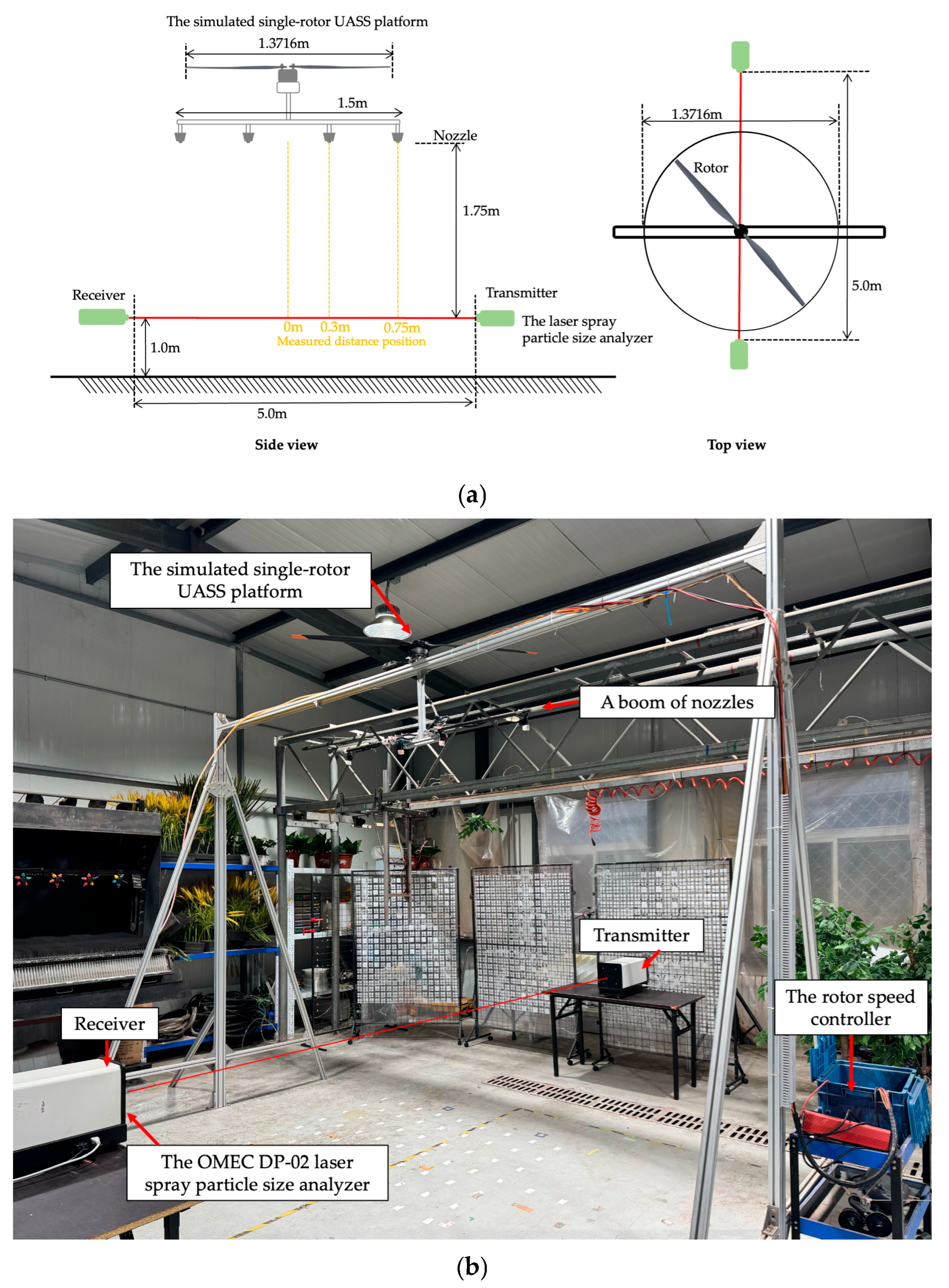

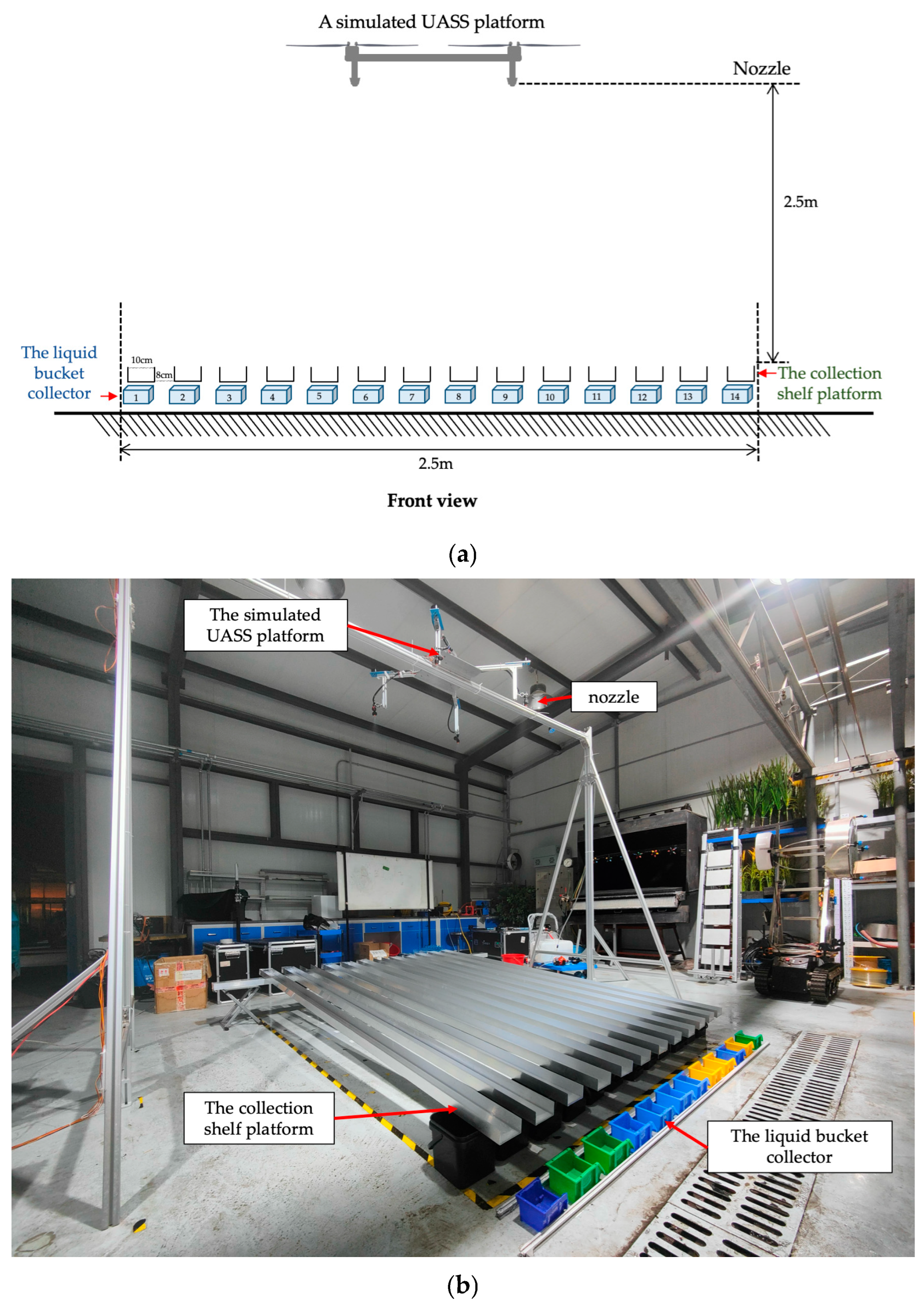
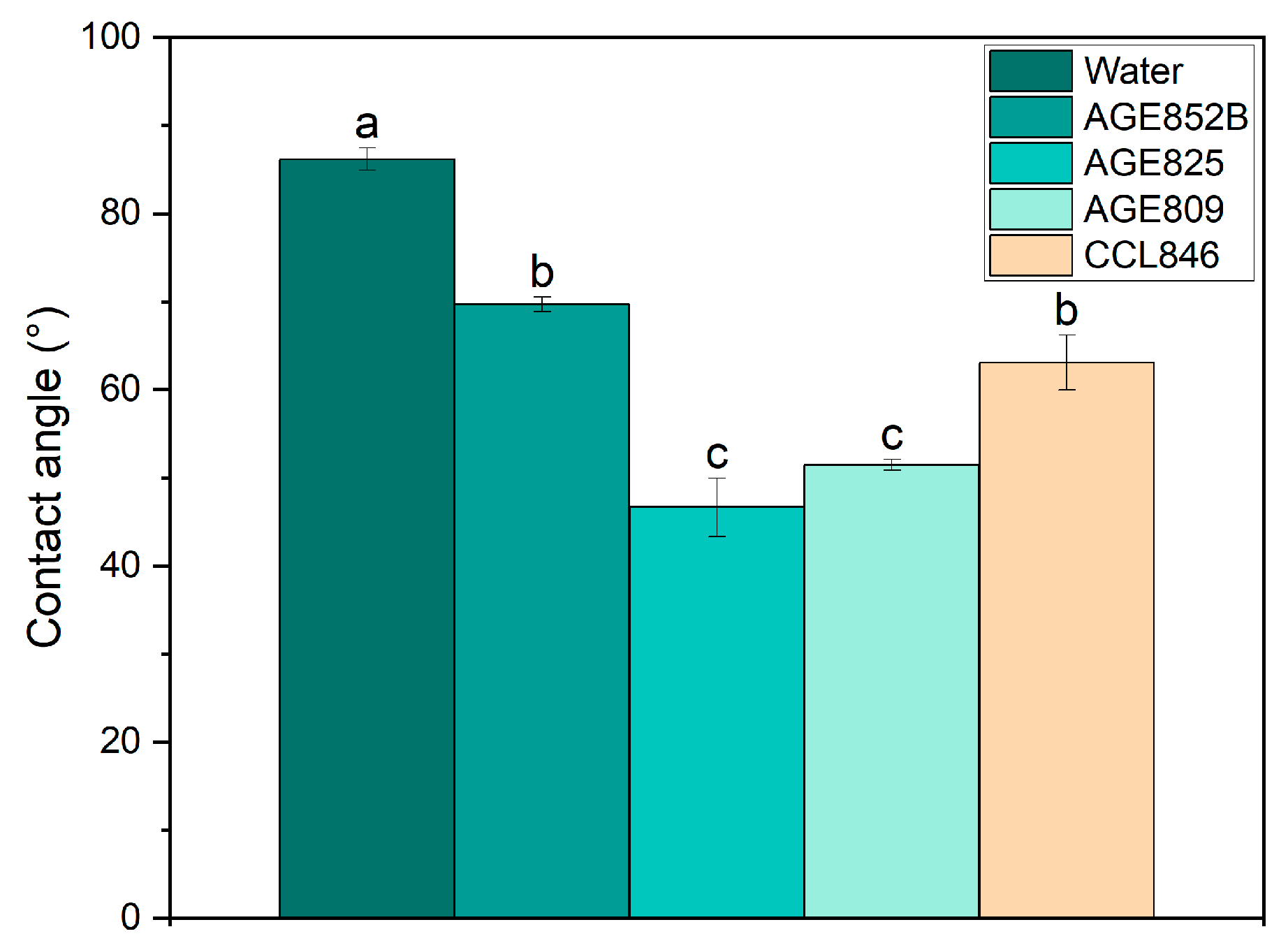




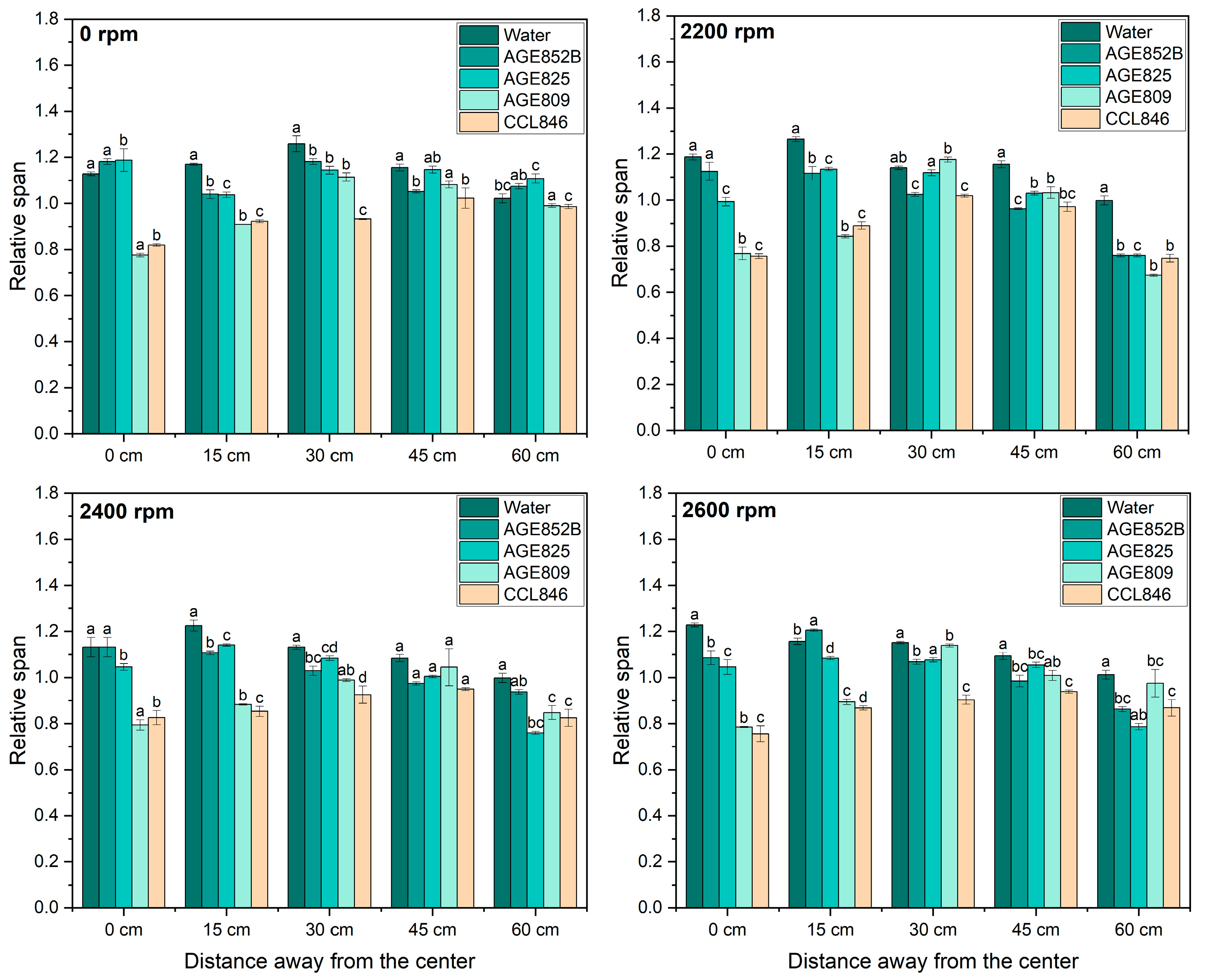
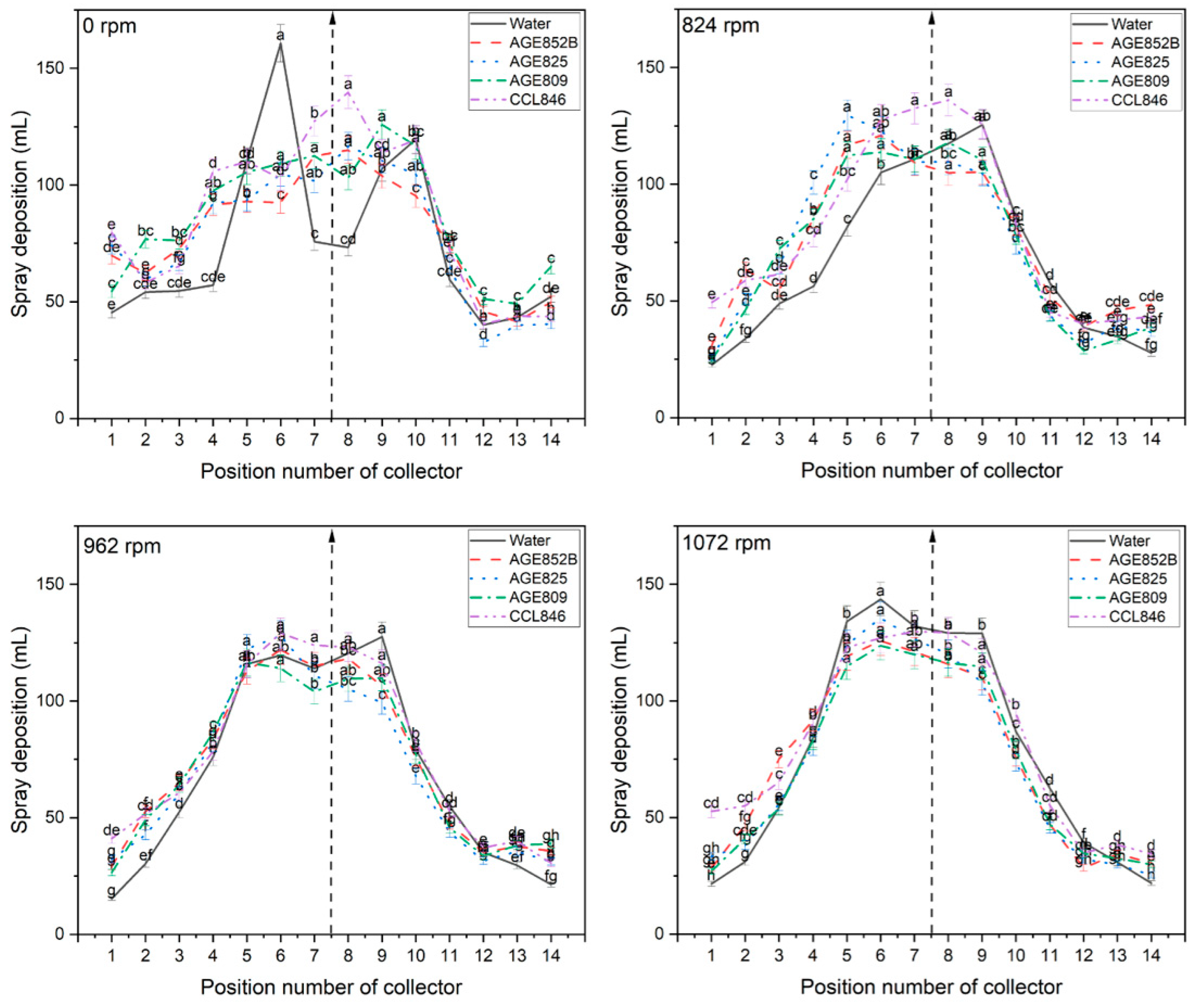
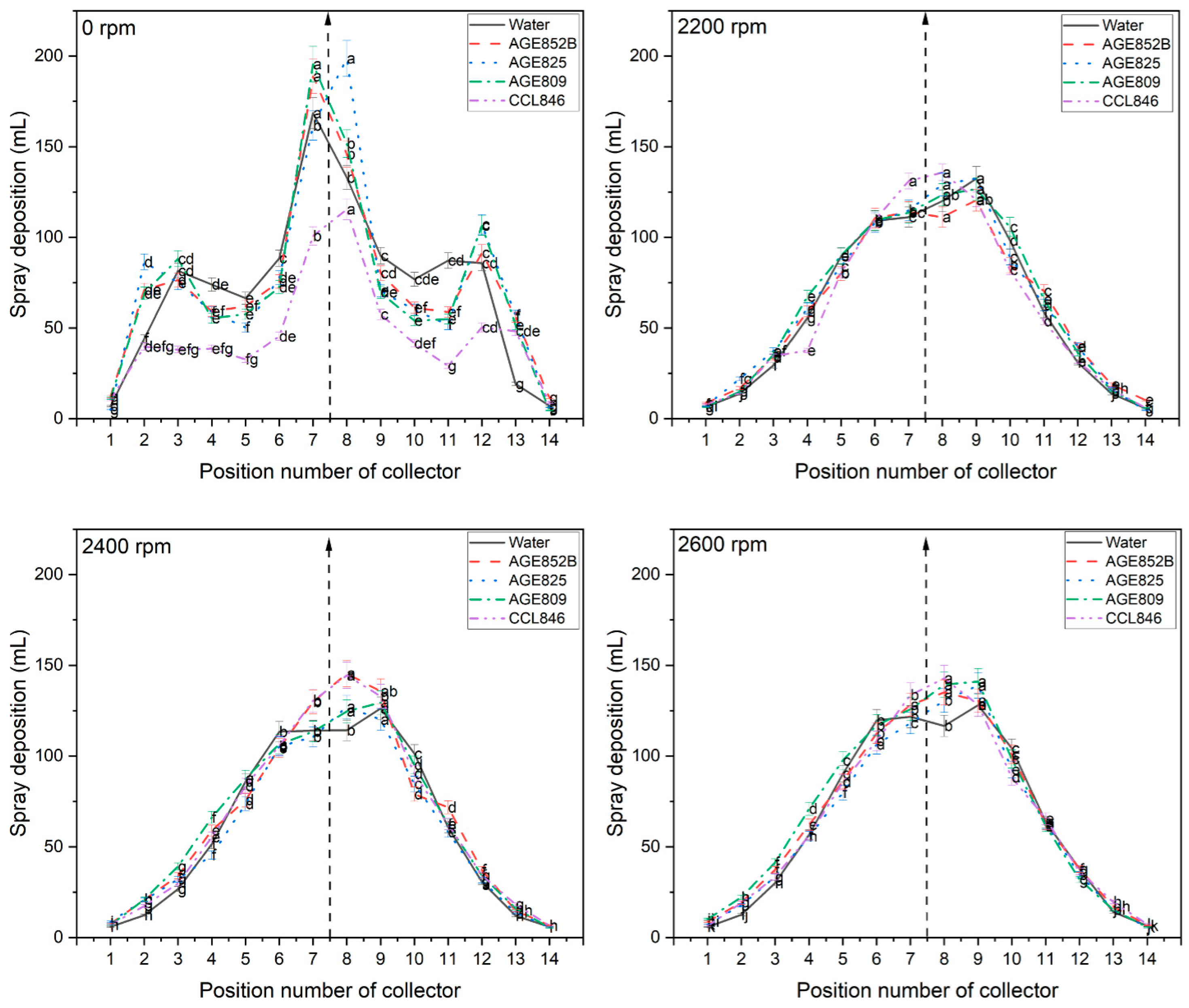
| Adjuvant | Ingredients | Contents (%) | Recommended Dosage (%V/V) |
|---|---|---|---|
| AGE852B | Ammonium sulfate | 40 | 2 |
| Methylated seed oil | 50 | ||
| Alkoxylated phosphate ester | 10 | ||
| AGE825 | Natural fatty acid | 71 | 2 |
| Guerbet alcohols, C10, ethoxylated NR | 28.2 | ||
| Calcium dodecylbenzene sulfonate | 0.8 | ||
| AGE809 | Soybean lecithins | 50 | 1 |
| Methylated seed oil | 24 | ||
| Alcohols, C11, ethoxylate (5 EO) | 26 | ||
| CCL846 | Water | 44 | 2 |
| Fatty acid methyl esters | 22 | ||
| Natural fatty acid | 14 | ||
| Alcohols, C16-18, and C18-unsaturated ethoxylated | 9 | ||
| Starch | 6 | ||
| Glycerol | 5 |
| No. | Adjuvant | Rotation Speed (rpm) | |
|---|---|---|---|
| Single-Rotor | Multi-Rotor | ||
| 1 | 2% AGE825 | 0 | 0 |
| 2 | 824 | 2200 | |
| 3 | 962 | 2400 | |
| 4 | 1072 | 2600 | |
| 5 | 2% AGE852B | 0 | 0 |
| 6 | 824 | 2200 | |
| 7 | 962 | 2400 | |
| 8 | 1072 | 2600 | |
| 9 | 1% AGE809 | 0 | 0 |
| 10 | 824 | 2200 | |
| 11 | 962 | 2400 | |
| 12 | 1072 | 2600 | |
| 13 | 2% CCL846 | 0 | 0 |
| 14 | 824 | 2200 | |
| 15 | 962 | 2400 | |
| 16 | 1072 | 2600 | |
| Source of Variance | DV50 | RS | V100 | ||||||
|---|---|---|---|---|---|---|---|---|---|
| p Value | Sig. | Correlation Coefficient | p Value | Sig. | Correlation Coefficient | p Value | Sig. | Correlation Coefficient | |
| Rotor speed (R) | 3.630 × 10−5 | ***, †, ‡ | 0.030 | 0.039 | *, †, ‡ | 0.073 | 7.070 × 10−10 | ***, †, ‡ | −0.133 |
| Distance (D) | 2.830 × 10−37 | *** | 0.334 ** | 1.095 × 10−8 | *** | −0.323 ** | 3.540 × 10−49 | *** | −0.526 ** |
| Adjuvant (A) | 7.574 × 10−68 | *** | 0.660 ** | 0.639 | NS | 0.017 | 1.455 × 10−48 | *** | −0.542 ** |
| R × D | 4.574 × 10−24 | *** | 1.364 × 10−5 | *** | 4.440 × 10−28 | *** | |||
| R × A | 3.352 × 10−16 | *** | 0.008 | ** | 2.856 × 10−10 | *** | |||
| D × A | 7.324 × 10−30 | *** | 1.193 × 10−8 | *** | 1.680 × 10−20 | *** | |||
| R × D × A | 3.719 × 10−13 | *** | 0.002 | *** | 2.165 × 10−7 | *** | |||
| Source of Variance | DV50 | RS | V100 | ||||||
|---|---|---|---|---|---|---|---|---|---|
| p Value | Sig. | Correlation Coefficient | p Value | Sig. | Correlation Coefficient | p Value | Sig. | Correlation Coefficient | |
| Rotor speed (R) | 2.893 × 10−6 | ***, †, ‡ | 0.070 | 6.321 × 10−21 | ***, †, ‡ | −0.130 * | 1.238 × 10−42 | ***, †, ‡ | −0.209 ** |
| Distance (D) | 5.292 × 10−91 | *** | 0.009 | 3.587 × 10−57 | *** | −0.174 ** | 5.443 × 10−105 | *** | 0.056 |
| Adjuvant (A) | 4.024 × 10−104 | *** | 0.517 ** | 1.673 × 10−80 | *** | −0.593 ** | 5.531 × 10−97 | *** | −0.393 ** |
| R × D | 2.489 × 10−63 | *** | 1.380 × 10−23 | *** | 8.232 × 10−56 | *** | |||
| R × A | 4.661 × 10−18 | *** | 1.542 × 10−6 | *** | 5.524 × 10−19 | *** | |||
| D × A | 1.038 × 10−41 | *** | 2.367 × 10−50 | *** | 1.225 × 10−47 | *** | |||
| R × D × A | 5.101 × 10−14 | *** | 2.450 × 10−13 | *** | 9.860 × 10−19 | *** | |||
Disclaimer/Publisher’s Note: The statements, opinions and data contained in all publications are solely those of the individual author(s) and contributor(s) and not of MDPI and/or the editor(s). MDPI and/or the editor(s) disclaim responsibility for any injury to people or property resulting from any ideas, methods, instructions or products referred to in the content. |
© 2024 by the authors. Licensee MDPI, Basel, Switzerland. This article is an open access article distributed under the terms and conditions of the Creative Commons Attribution (CC BY) license (https://creativecommons.org/licenses/by/4.0/).
Share and Cite
Wongsuk, S.; Li, Y.; Zhu, Z.; Yang, M.; Zhang, H.; Zhang, L.; Wang, C.; He, X. Effects of Tank-Mix Adjuvants on Spray Performance Under Downwash Airflow Fields Using an Indoor Simulated UASS Spraying Platform. Drones 2025, 9, 6. https://doi.org/10.3390/drones9010006
Wongsuk S, Li Y, Zhu Z, Yang M, Zhang H, Zhang L, Wang C, He X. Effects of Tank-Mix Adjuvants on Spray Performance Under Downwash Airflow Fields Using an Indoor Simulated UASS Spraying Platform. Drones. 2025; 9(1):6. https://doi.org/10.3390/drones9010006
Chicago/Turabian StyleWongsuk, Supakorn, Yangfan Li, Zhaoyan Zhu, Mengran Yang, Hao Zhang, Li Zhang, Changling Wang, and Xiongkui He. 2025. "Effects of Tank-Mix Adjuvants on Spray Performance Under Downwash Airflow Fields Using an Indoor Simulated UASS Spraying Platform" Drones 9, no. 1: 6. https://doi.org/10.3390/drones9010006
APA StyleWongsuk, S., Li, Y., Zhu, Z., Yang, M., Zhang, H., Zhang, L., Wang, C., & He, X. (2025). Effects of Tank-Mix Adjuvants on Spray Performance Under Downwash Airflow Fields Using an Indoor Simulated UASS Spraying Platform. Drones, 9(1), 6. https://doi.org/10.3390/drones9010006








